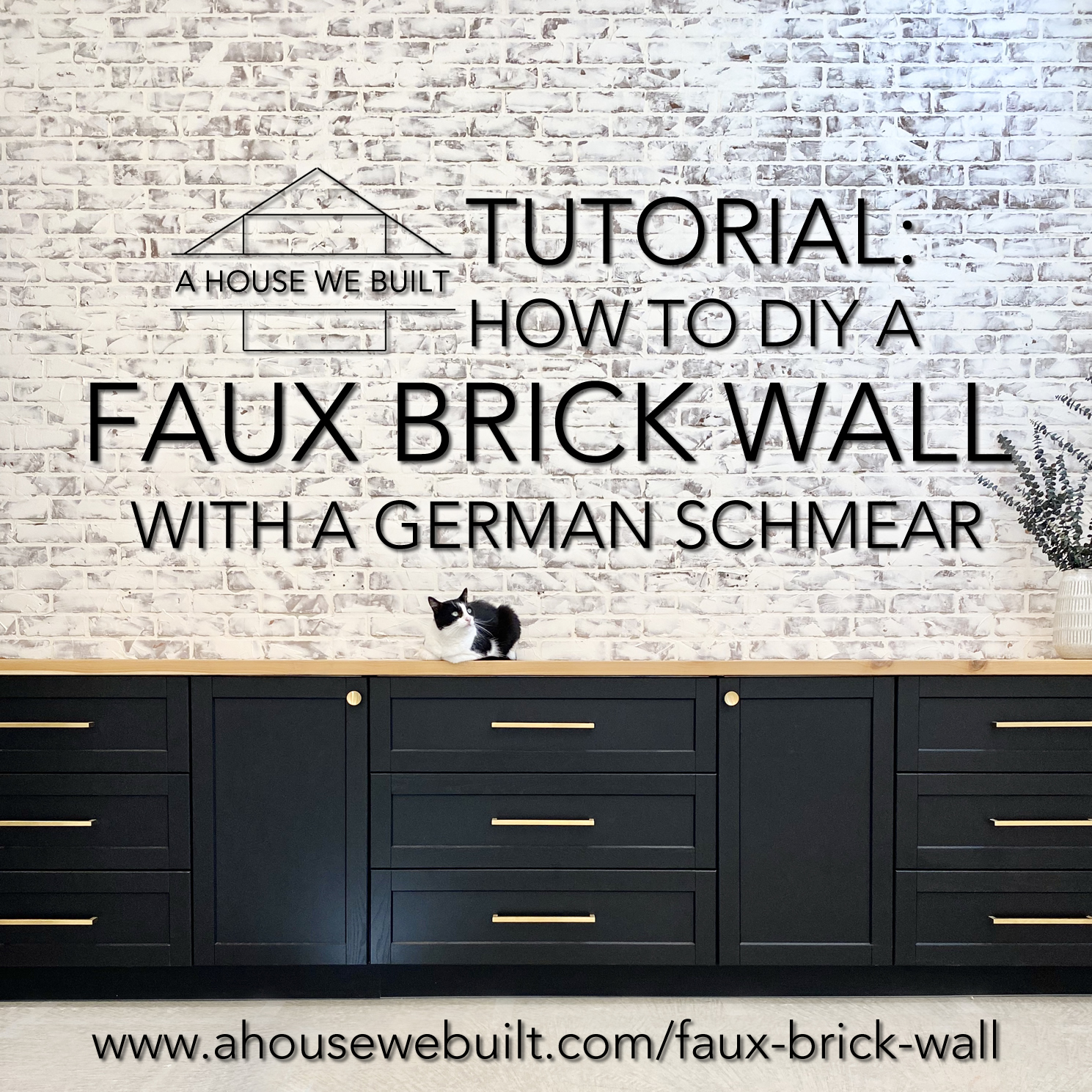
Ever since we started designing our house, I’ve loved the idea of doing a brick wall somewhere. It’s rustic, cozy, and industrial and depending on how you style it, it can also be very modern. But real brick walls are not only expensive but also very time consuming to install, not to mention quite permanent, so I started exploring the idea of a “faux brick wall” instead BUT I wanted it to look real. There are many options for how to do this and I’m pretty sure I’ve researched every one of them at this point. The reason I settled on using this method that I’m going to share with you here was that it was the perfect combination of everything I was looking for: It looked real, it felt real, it was easy to DIY, it was cost effective, and most importantly it gave me exactly the look I was going for. So, here’s how we did this accent wall…
Also, you can visit our Game Room page to see how this room turned out!
SUPPLY LIST FOR BRICK PANELS & INSTALLATION:
- Brick wall panels: Home Depot (I used 3, and this particular panel is by far the BEST I’ve found)
- Jig saw: Home Depot (needed to precisely cut the brick panel edges)
- Construction adhesive: Home Depot (2 tubes of this per panel, so I needed 6 tubes)
- Carpenter’s square: Home Depot
- Brad nailer: Home Depot
- Level: Home Depot
- Ladder: Home Depot
- Pencil
SUPPLY LIST FOR GERMAN SCHMEAR & APPLICATION:
- Pre-mixed joint compound: Home Depot (for 3 panels, I used half this container, but the smaller container isn’t enough so it’s better to buy this size and save the rest for future projects)
- Plastic putty knives: Home Depot (I used both the smallest and biggest of this set, very important to use plastic, not metal knives as metal will damage the panels)
- Drywall hawk: Home Depot (this isn’t 100% necessary but it makes work SO much easier)
- Ladder: Home Depot
- ~1 cup water
HOW TO MAKE THE WALL:
- PREPARE BRICK PANELS.
- INSTALL BRICK PANELS.
- GERMAN SCHMEAR.
STEP 1: PREPARE BRICK PANELS.
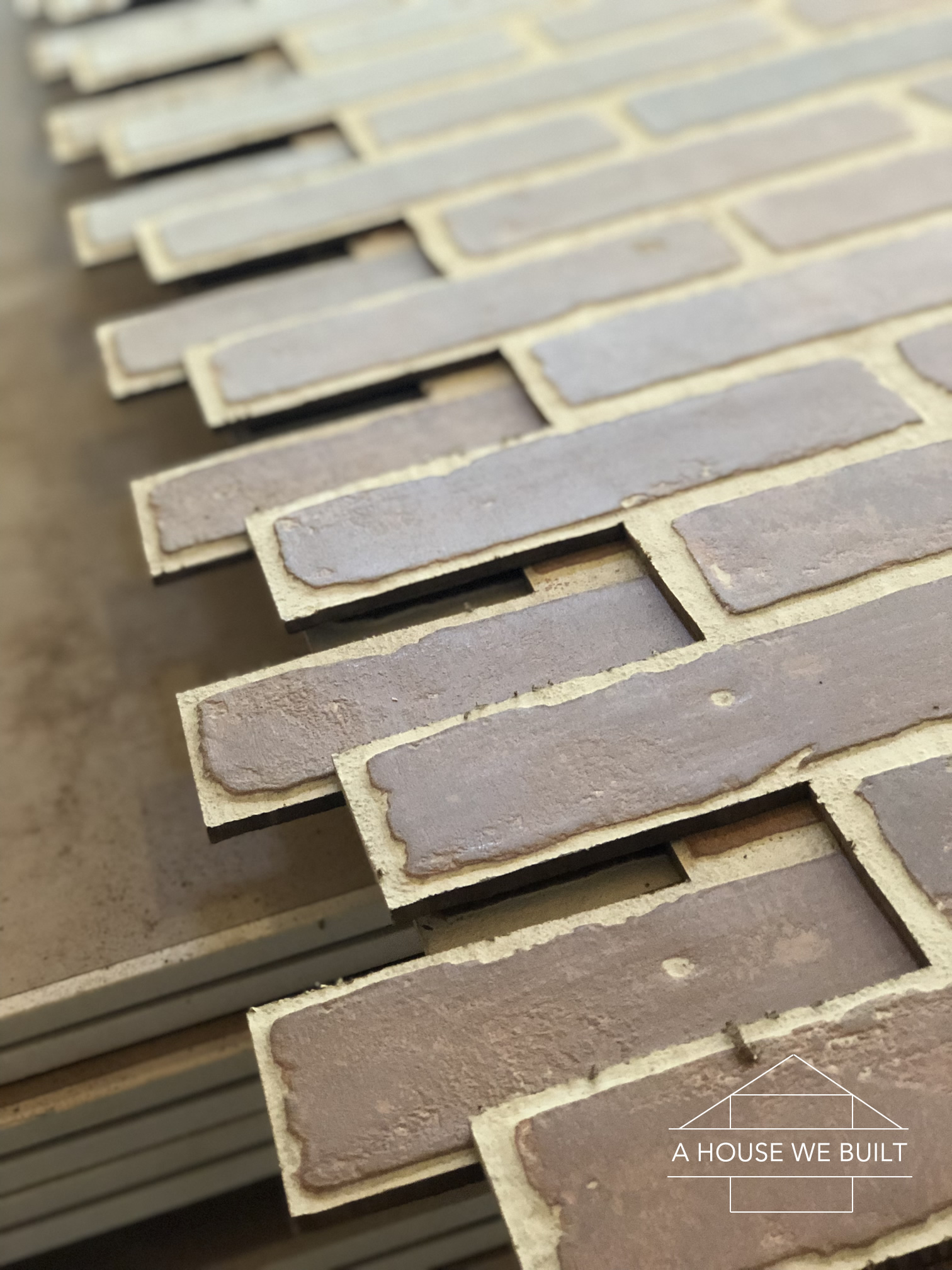
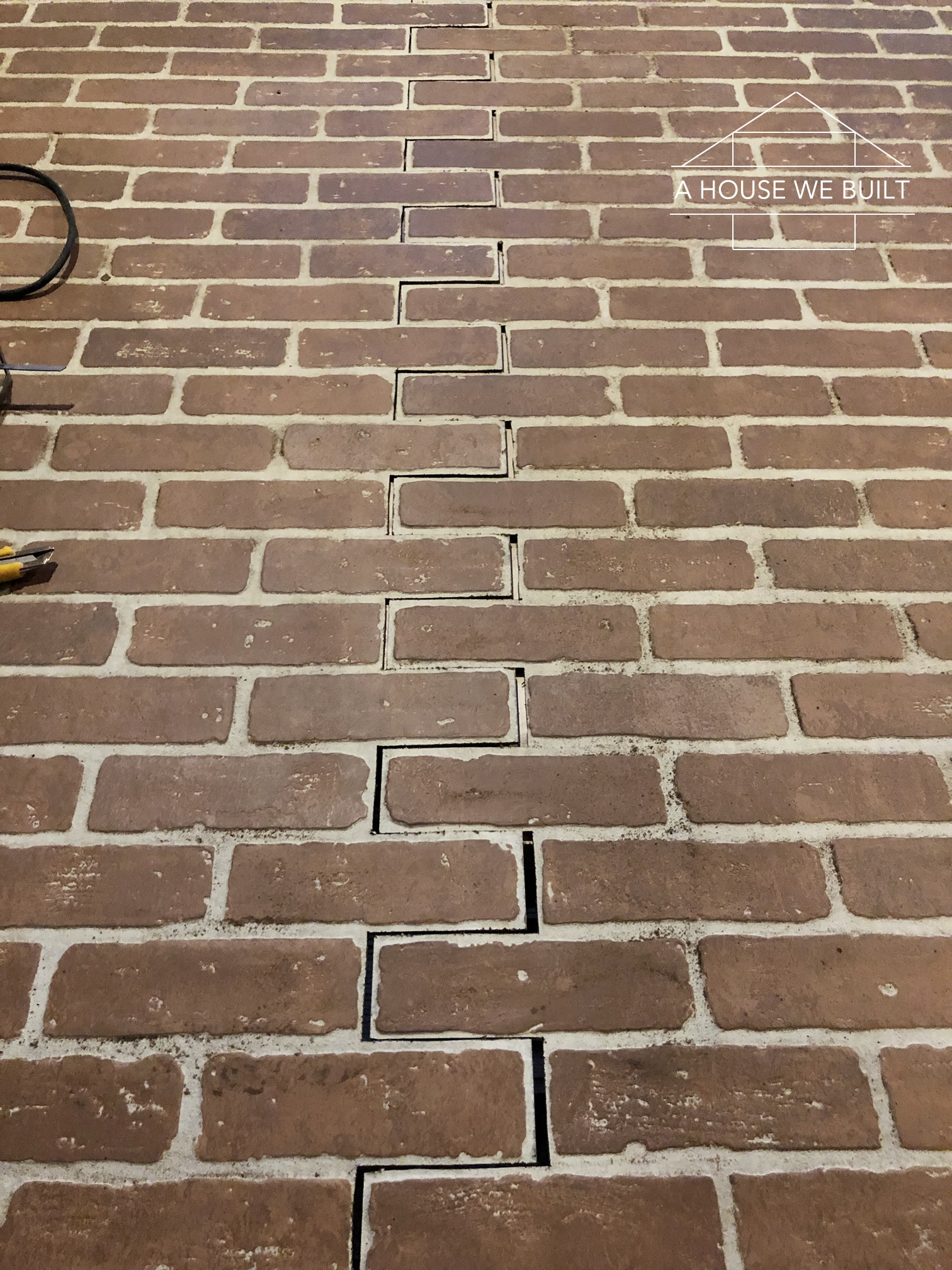
I did a lot of research before choosing these brick panels to use for this project. I chose them because they’re realistically formed with a 3-dimensional textured and raised imprint, and the pattern doesn’t repeat so even if you put three of these panels beside each other, like I did, it looks real.
The downside is that because they come in 4×8 evenly rectangular boards, that means that if you simply put three of them in a row as-is, you’re going to see a seam between them no matter how talented you are with joint compound because every other half-brick along the seam will visually be cut in half.
So the secret to making these panels turn into what looks like a real brick wall was to cut out every other half-brick along the edges (as shown in the pics) so that the panels could literally interlock and this was definitely something that could be hidden with joint compound even if you have no experience!!
To do this, we first outlined the cut lines with a pencil and carpenter’s square. You want to be sure you’re cutting in the middle of the grout line.
We used a jig-saw (like this one) to make the cuts. This is a labor of love which my dad very kindly did for us (thanks Dad!!!!) but it is absolutely essential to making your faux brick wall look real.
Once you’ve cut all your panels, lay them out on the floor beside each other and make sure that they actually interlock properly. If there are little spots that don’t fit, it’s easy to make additional cuts now to fix that, but if you skip this step you’ll be in big trouble when you install them. If you have a little extra space between the panels in some places (even up to 1/2″), don’t worry – that can all be hidden later.
Note: because of the nature of the cuts, you will need to take one brick row off the bottom of one of the panels so that the panels can actually interlock. I recommend removing the row from the bottom as it will be less obvious. And again, make sure you are cutting in the middle of the grout line.
Note: depending on how many panels you need to make your wall, the sides you cut will be different. I needed 3 panels so the Left Panel needed the right side edges cut, the Middle Panel needed both left & right edges cut, and the Right panel needed the left side edges cut. You need to basically cut anywhere that one panel joins another panel, but don’t cut the edge that goes against a wall because you need that one to be straight. (The pics below show what I mean by this.)
STEP 2: INSTALL BRICK PANELS.
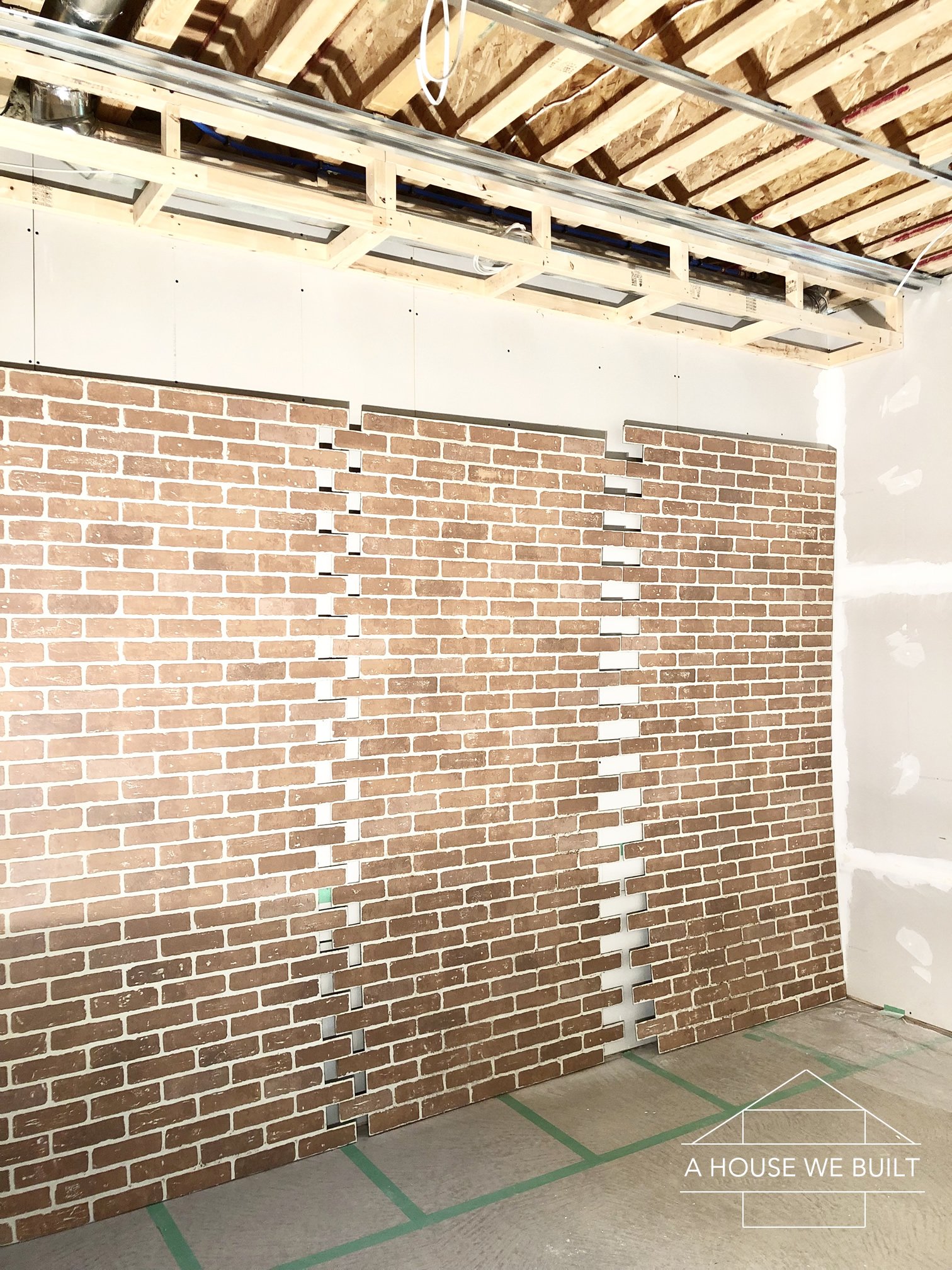
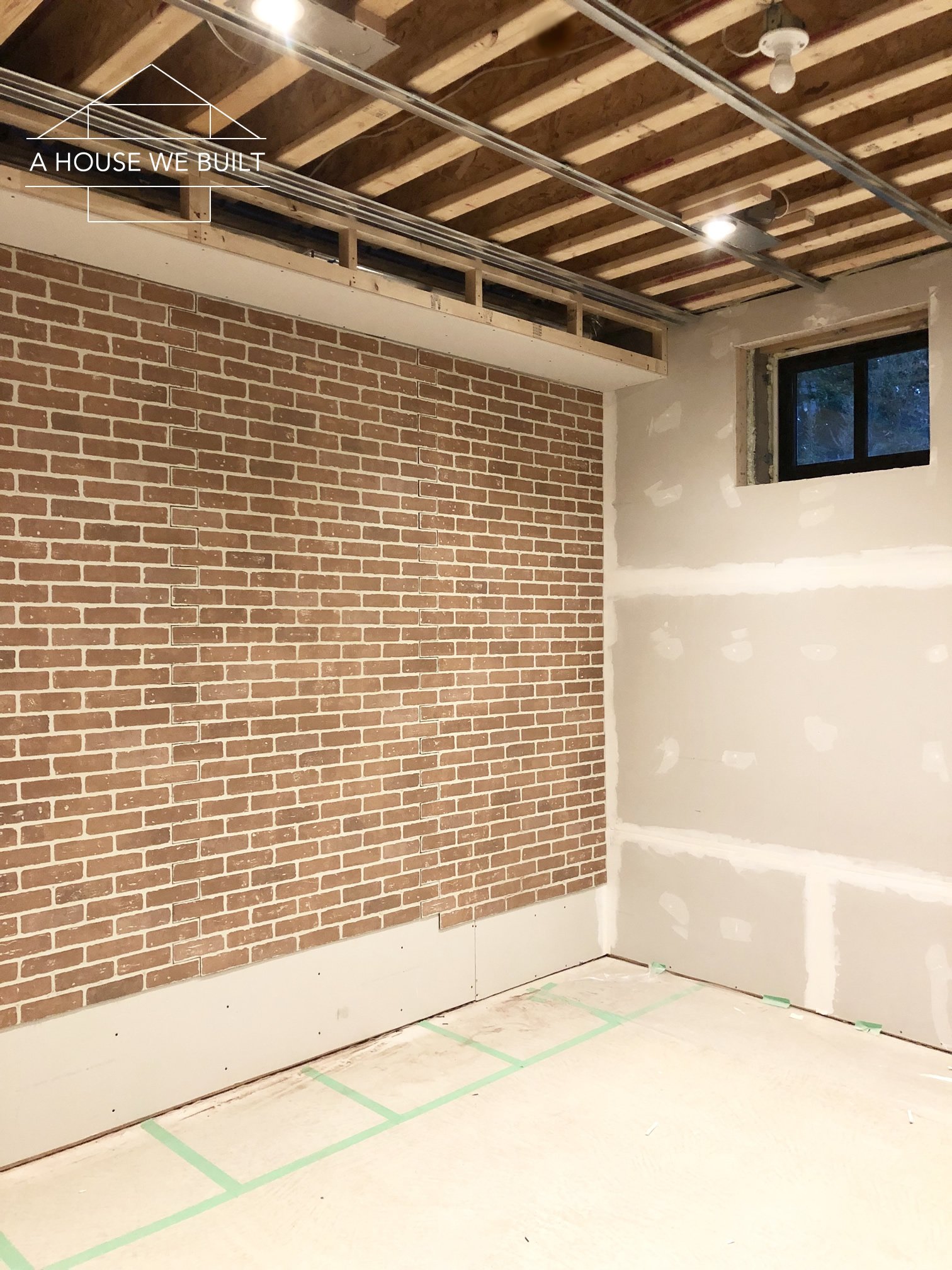
We installed our now pre-cut brick panels using a combination of both construction adhesive (you’ll need 2 tubes per panel so make sure you have all the tubes you need on hand) and a brad nailer for added reinforcement. In my opinion, you need both of these (the adhesive and the nailer) to properly install these panels. If you just use adhesive you risk sagging, if you just use the nailer you risk unevenness.
Start with either the far left or far right panel (whichever has a corner edge). Lay the brick panels face-down on the floor and apply the adhesive. When you’re applying the adhesive, make sure it’s even and that you run a line down every one of the protruding brick cuts so each one gets glued to the wall.
It takes 2 people to install the panels. Lift your panel into place and square it up with your ceiling and corner, then use a level to make sure it is level both horizontally and vertically. Don’t worry if there’s a bit of a gap on the sides or top (up to a 1/2″) – you can fix this with the compound in the next step.
Once your brick panel is in place, use a brad nailer with 18-guage nails to secure the panel to the wall (preferably into the studs) and make sure you put a nail into each of the individual brick cut edges. It’s a good idea to make a note of where your studs are before you start, but mark them on the floor with tape or something because your wall is about to get covered by the panel.
Then repeat until all the panels are installed. Make sure you check that each one is level. You may need to use a rubber mallet or a solid thump with the palm of your hand to make the brick cut edges interlock.
STEP 3: GERMAN SCHMEAR.
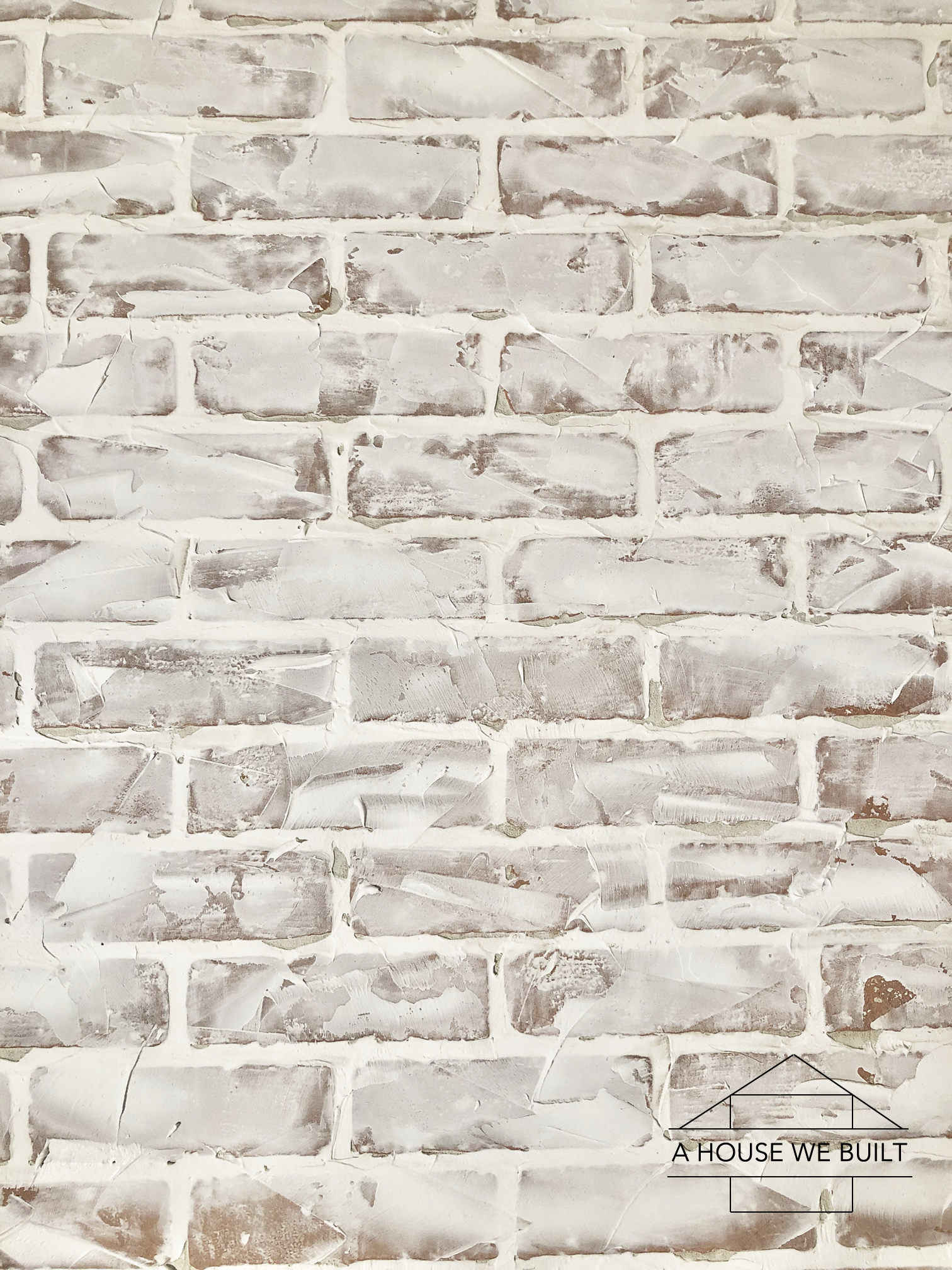
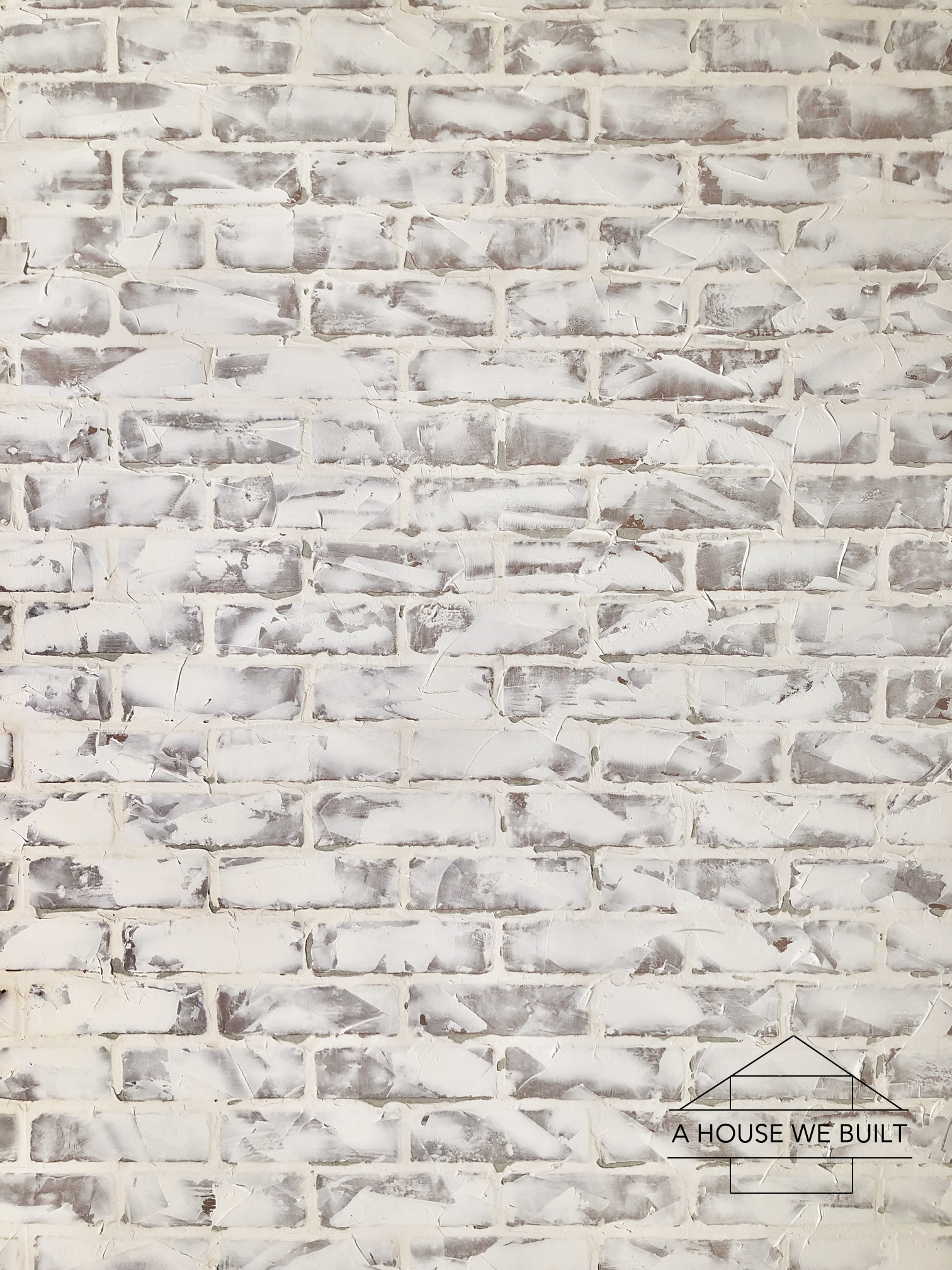
You will need 5 things to do this step:
First you’ll need pre-mixed joint compound. I use this particular kind because it’s less dusty, and has a drying time of 24 hours. This is SO important because you want to be able to do your whole wall, then go back and make adjustments here and there before it dries, so whatever you do, do not get a fast drying compound. I used half that container for my 3 panels, but it’s a good product to have on hand so I don’t mind having extra, and the smaller size it comes in isn’t enough to complete this project so this was my best option. And I way prefer this pre-mixed compound to the mix-it-yourself kind because omg it’s such a time-saver! Also, grab yourself a glass of clean water to have on hand. I’ll explain why down below.
For your application tool, you’ll need plastic putty knives. I got this inexpensive set and used both the biggest and smallest ones. You need plastic because metal ones will damage the brick panels.
To make your life easier, I recommend using a drywall hawk to hold your joint compound and the style that I linked is what I consider to be the most ergonomic one and it shouldn’t make your arm ache during the couple hours it’ll take you to do this project. This is a nice-to-have (but not a need-to-have) item.
Finally, you might need a ladder (I love this light-weight one) since these are 8-foot high panels. Our basement ceilings are 10-ft high and even though we installed these panels below a bulkhead, it was still super helpful to have a ladder to work on.
Ok, so now that you have all your tools and materials, here’s what to do with them.
First, I suggest thinning out your drywall compound just a little bit. You don’t have to do this, you can certainly just use the compound straight out of the tub, but I find that a little water makes it easier to work with. So use the small putty knife to scoop out about 2 cups of the joint compound onto the middle of your drywall hawk. Then make a little indent/hole in the middle of the compound glob and pour about 1-2 tablespoons of water into the center, then slowly mix it into the compound. The final consistency you’re looking for is kinda like creamy mashed potatoes. It should be smooth enough to easily stir BUT firm enough that it won’t slide off the hawk if you tip it at a right angle to the floor.
Put the lid firmly back on your compound tub (it will dry out if you don’t) and clean off the small putty knife. Clean everything as you go!
To get started on the next part, grab your biggest putty knife out of the set I showed, along with your hawk with the mixed compound, and your ladder and now it’s time for the exciting part!!
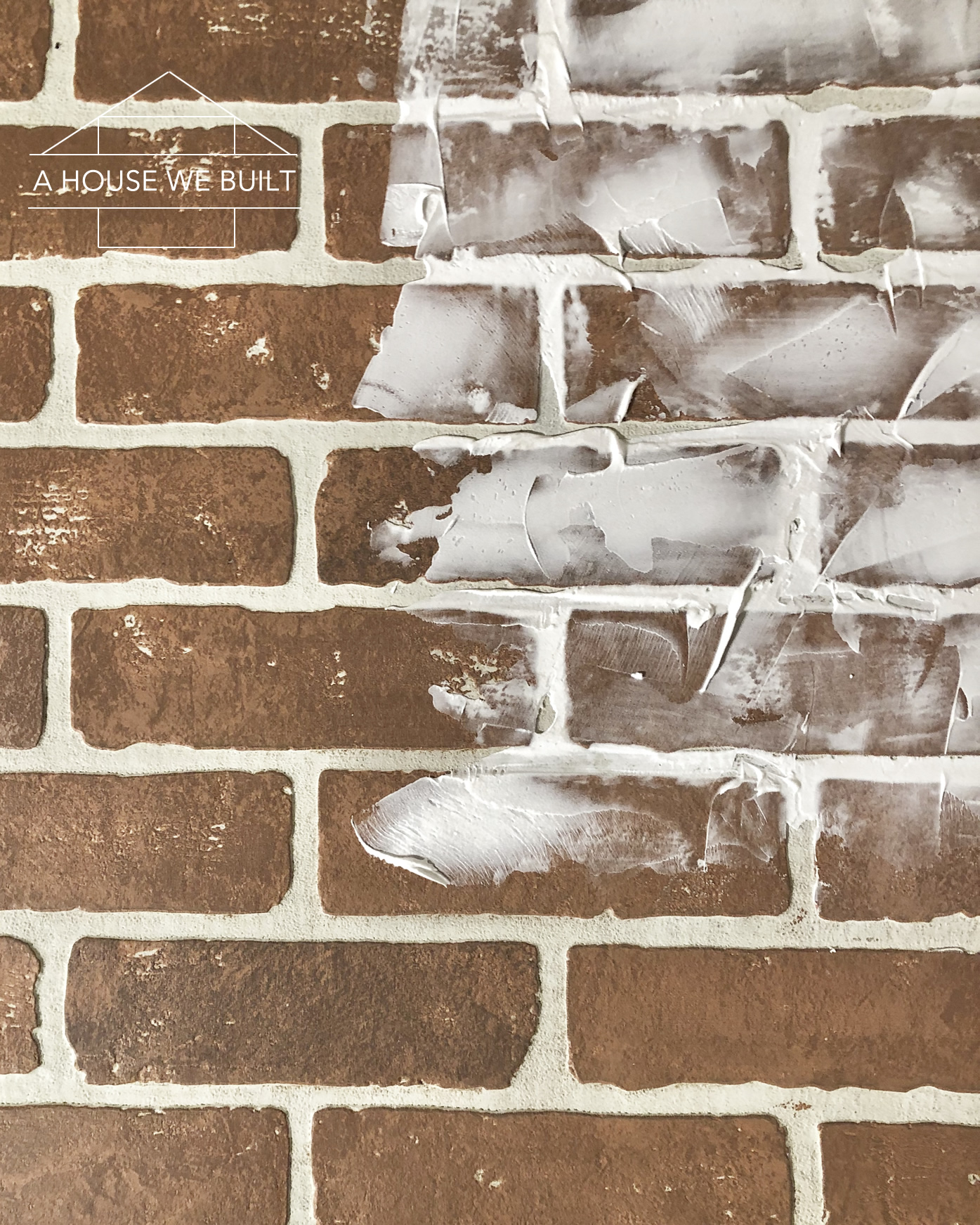
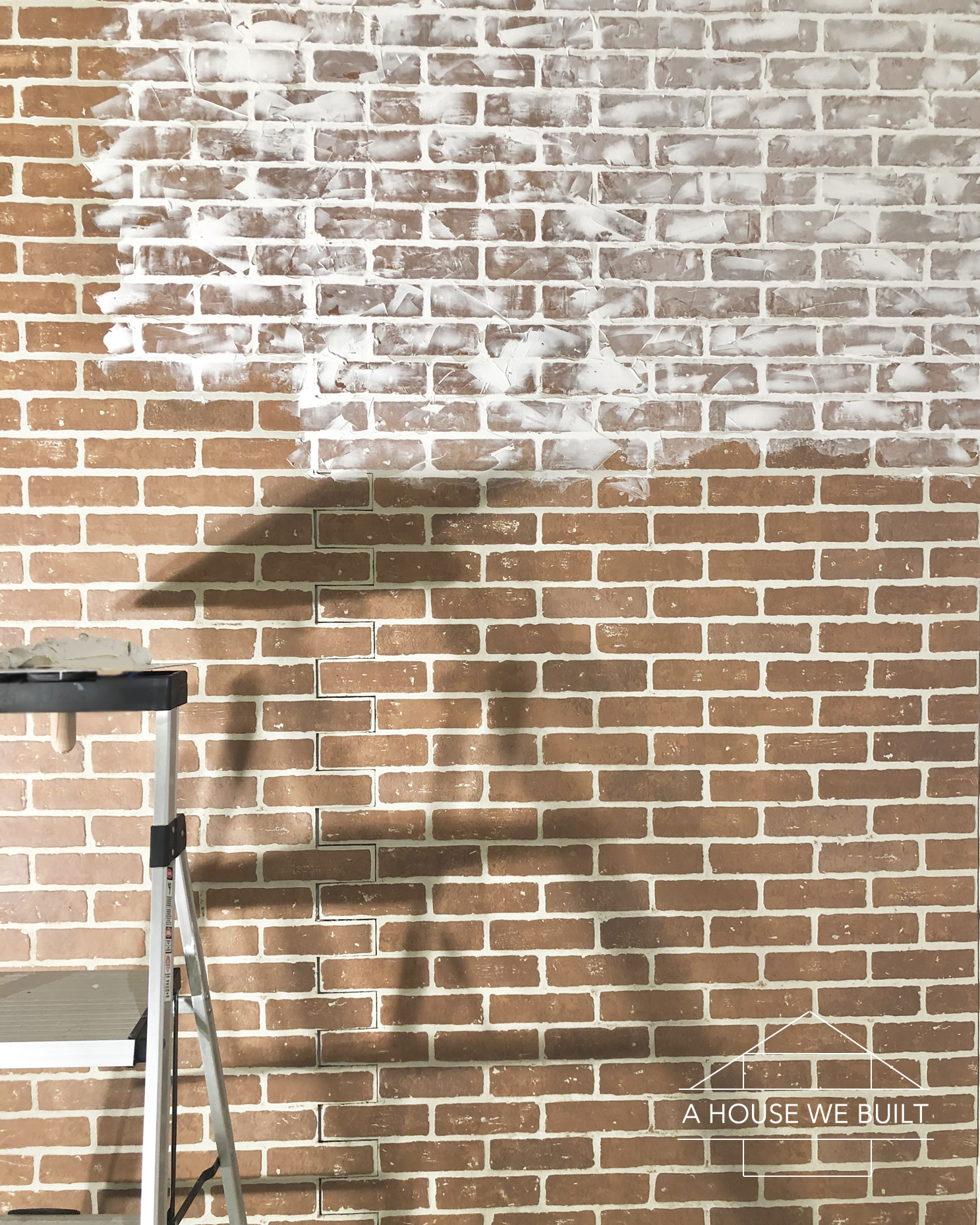
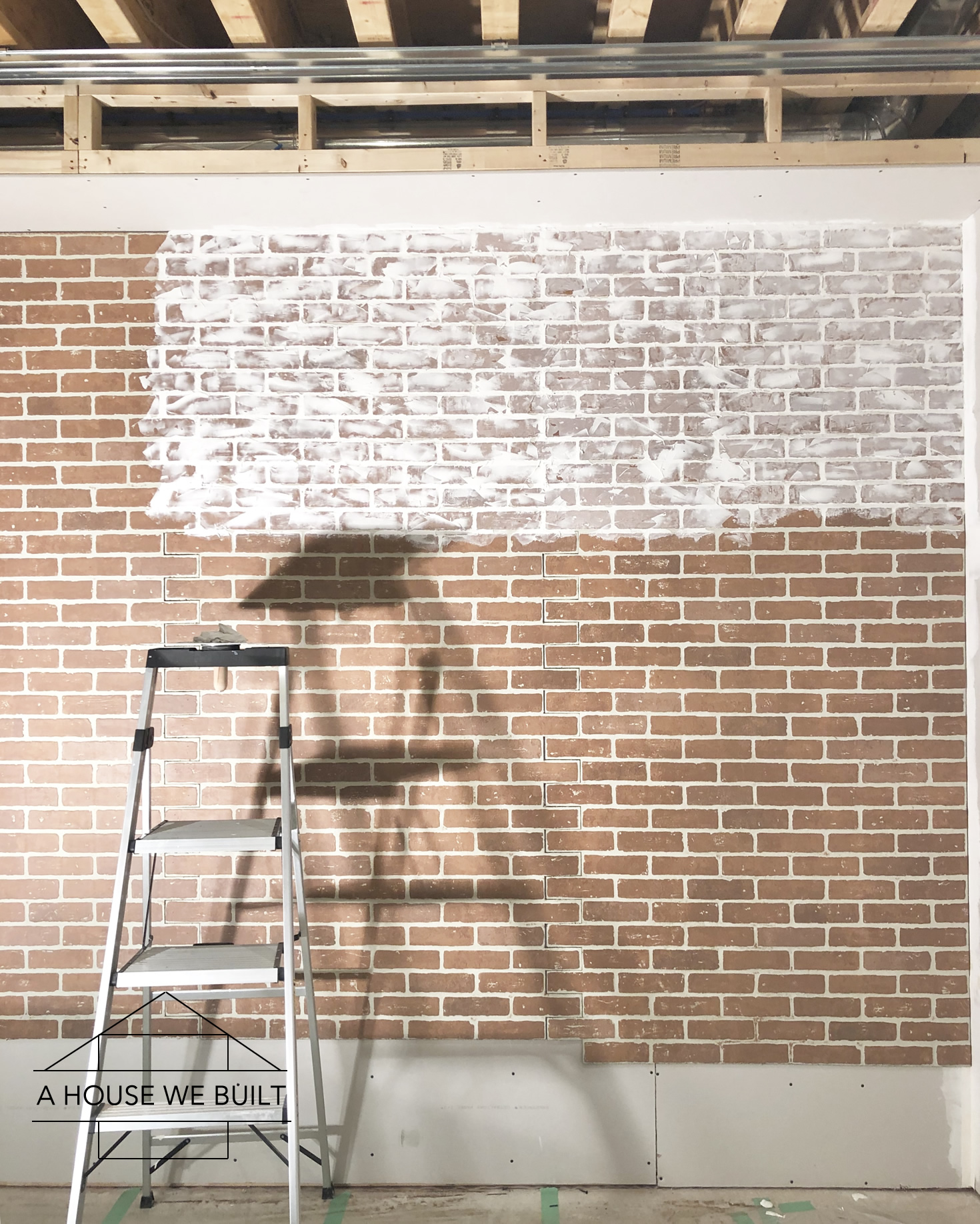
To do the “schmear” you just grab a big a glob of the compound on your putty knife (I’m guessing about 1/4 cup) and scrape it onto the wall. Then literally just scrape it around going left, right, up, down, sideways, whatever way you want until you’re happy with the look. I recommend doing about 1 square foot at a time. There is really no wrong way to do this, it’s just about whatever look you want. I recommend getting the compound into the grout lines in most places, but let a bit of the original grout show through here and there for added depth. Basically you’re smearing it on, then scraping it off in every possible direction until you have as much or as little of it on as you want on the wall and you’re happy.
Be sure you get extra compound into the top and side seams between the panels and the wall/ceiling so that there are no holes or gaps there. This is very important to making your wall look finished.
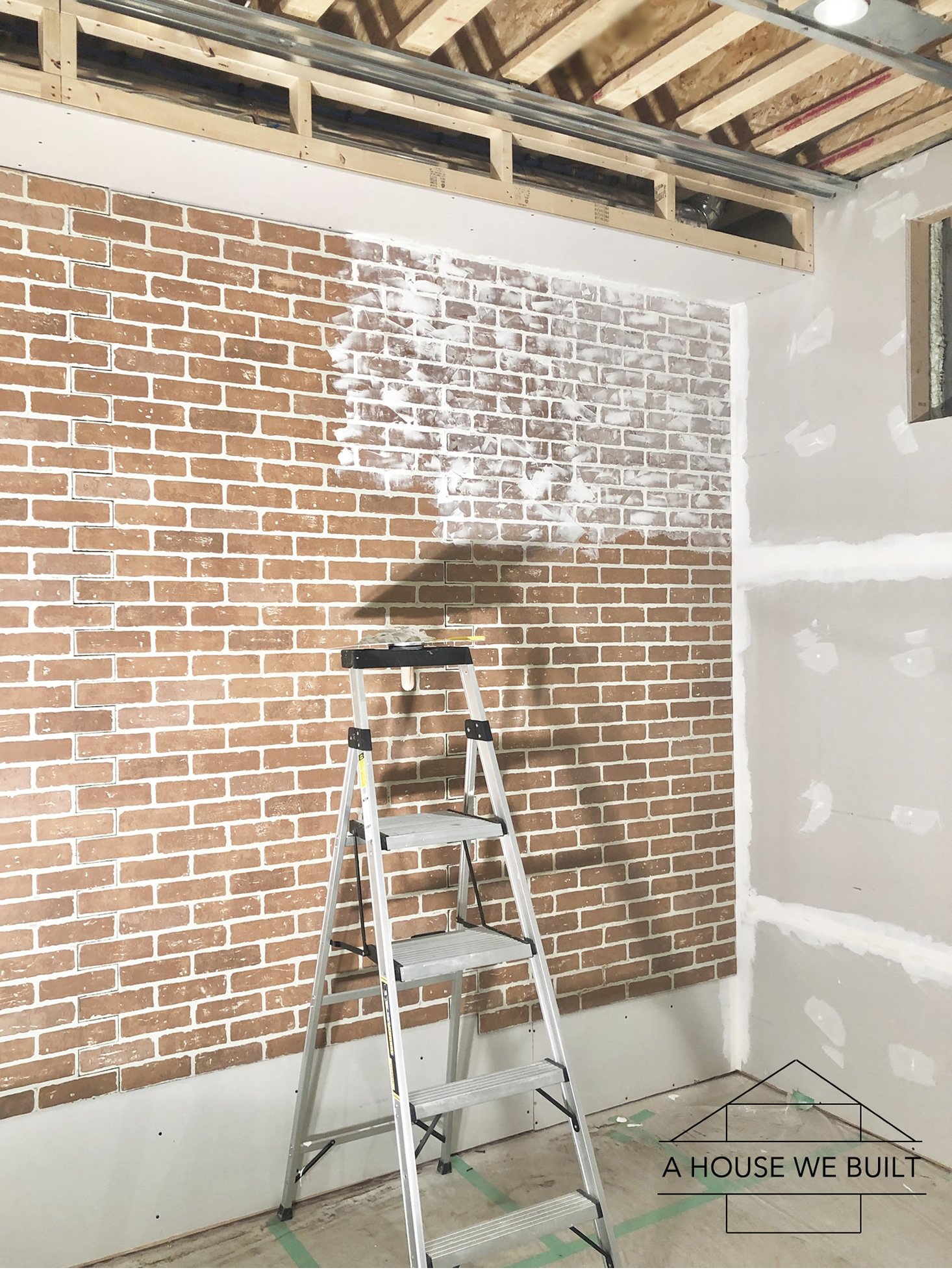
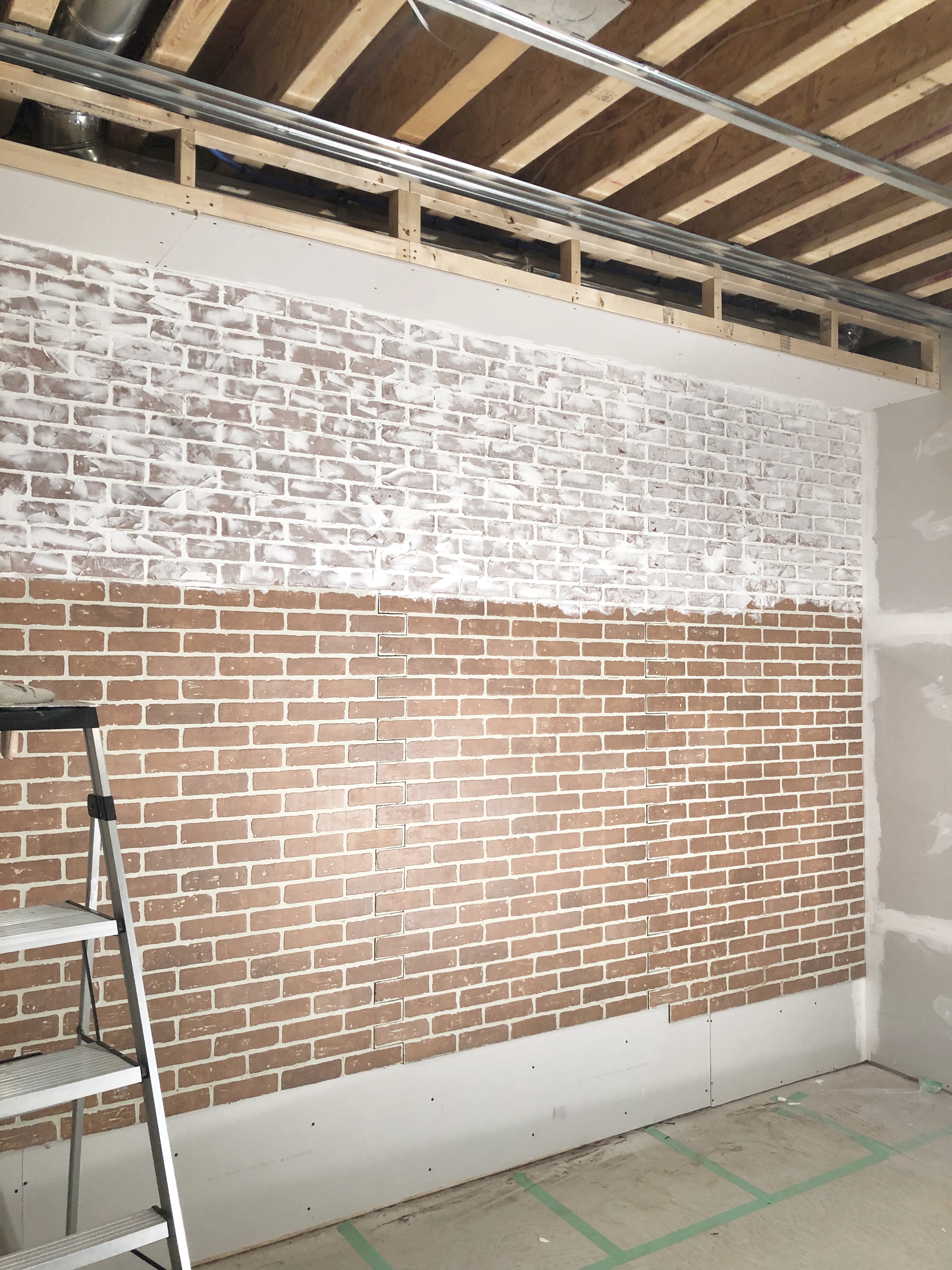
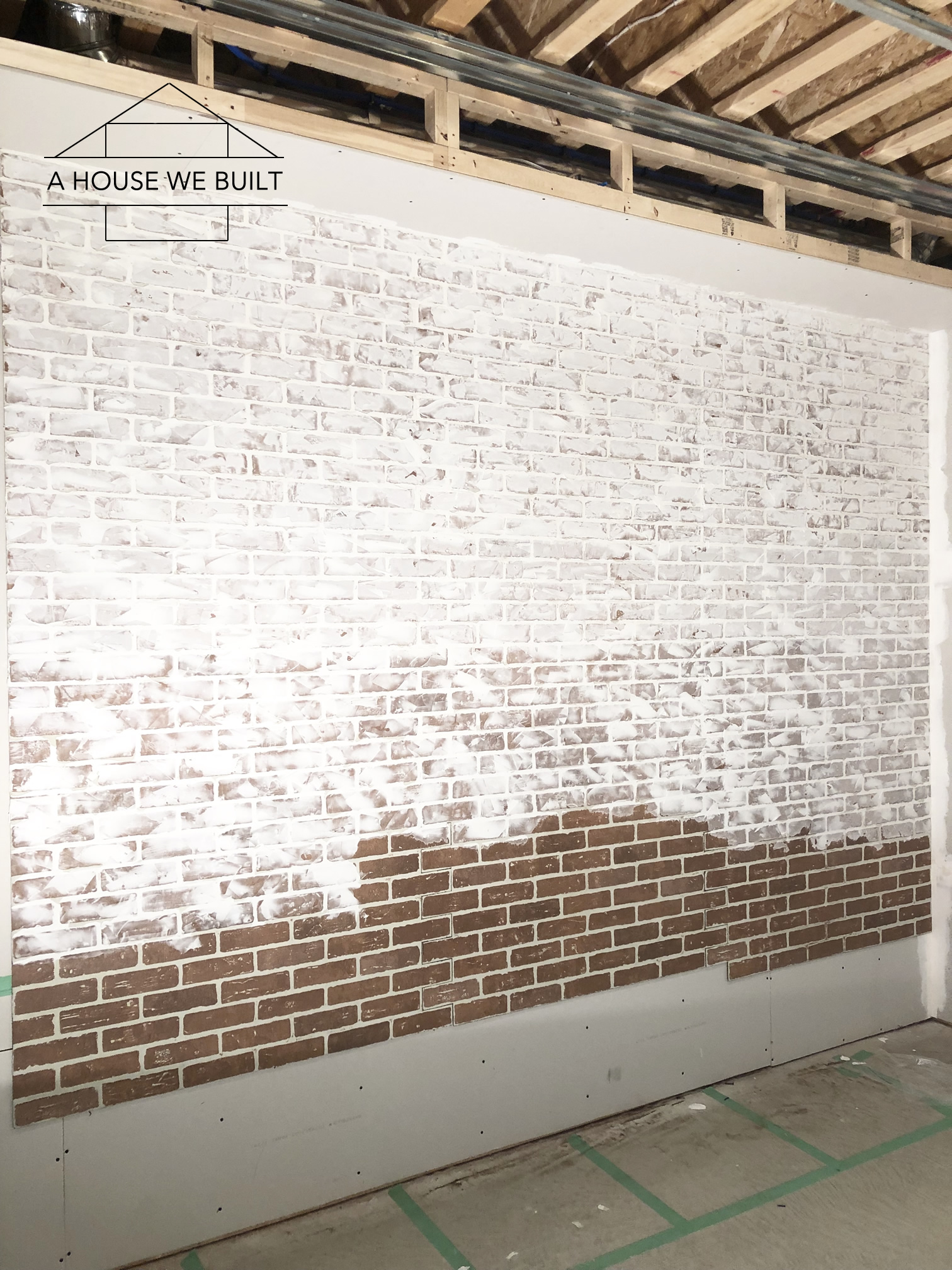
When it comes time to do the seams between the panels, just use extra compound and push it into the cracks between the panels and smear/scrape the compound around until you hide the seam. You might notice that the line/crack between the panels falls in a little as it dries (middle pic below) – don’t worry about that. Make it as good as you can on the first day, then go back the next day and fix up the seam line (third pic below) even maybe with just applying the compound with a finger. It’s pretty forgiving.
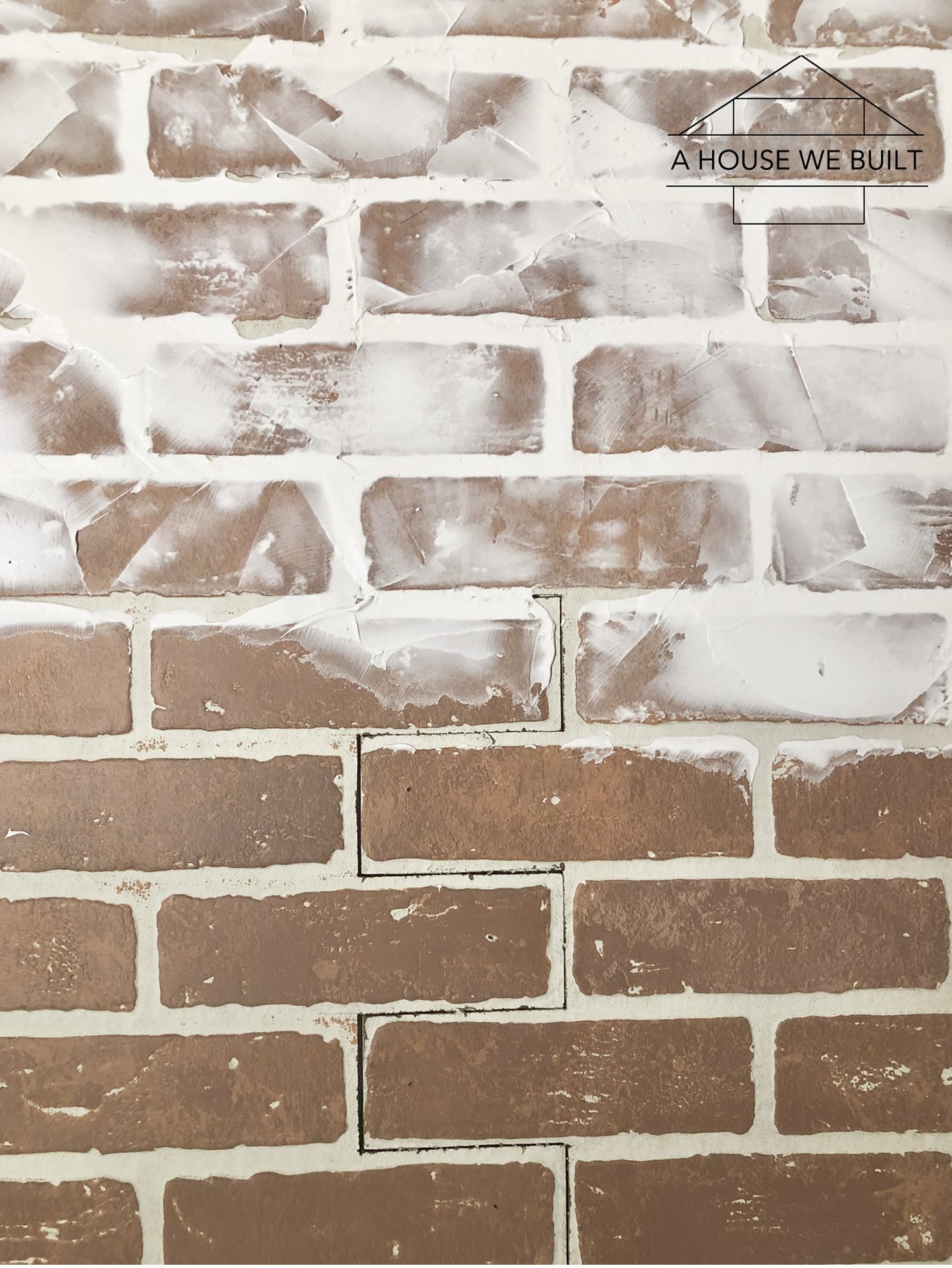
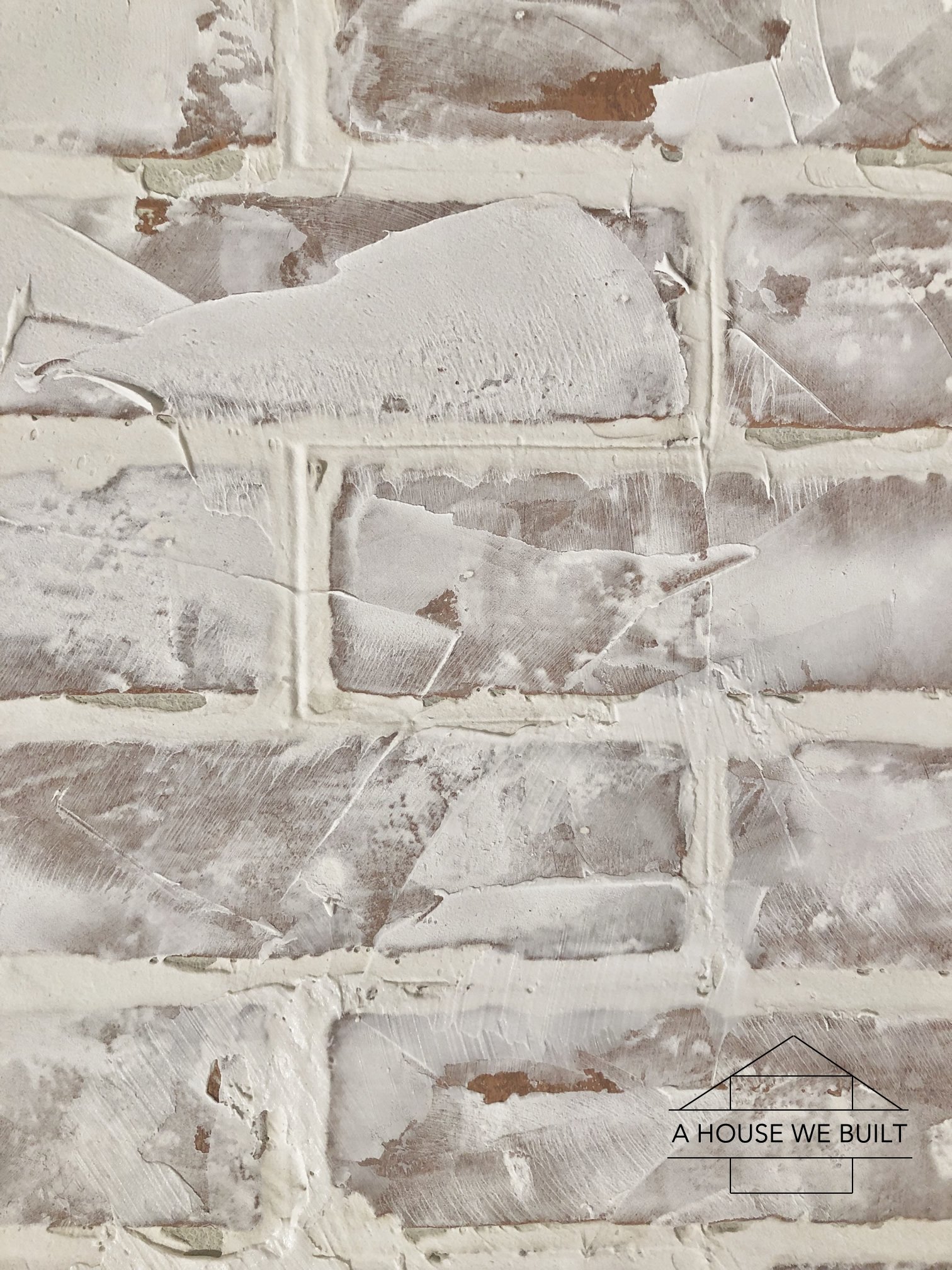
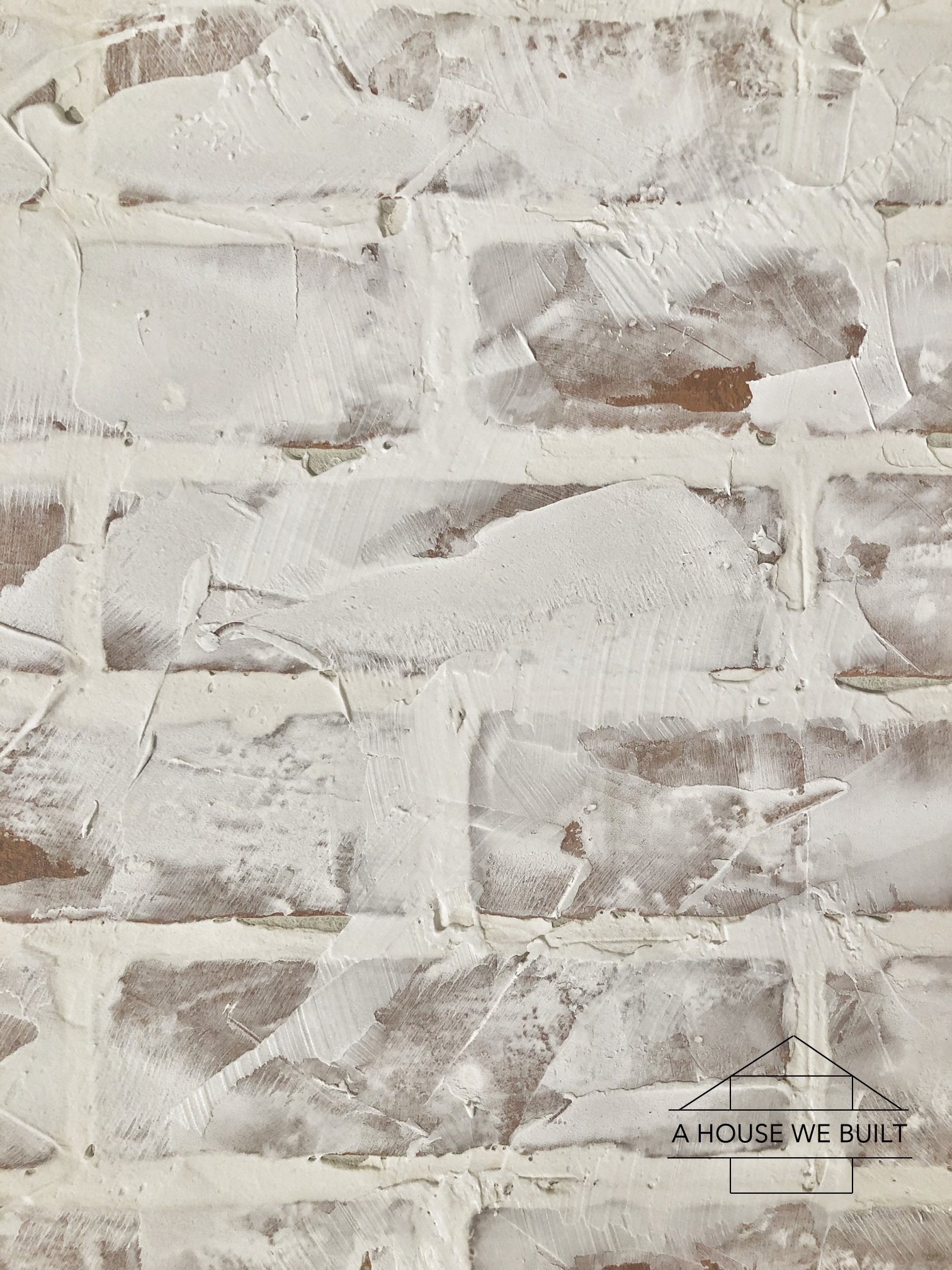
You’ll want to work in even sections along the wall and try to stand back every time you move the ladder and make sure that you’re being consistent with your application. I also found it helpful to look at the wall through my camera phone. Don’t ask me why but looking at your work through something else often helps you notice trouble spots. Remember, the less ‘perfect’ it looks, the better!
I personally didn’t worry about making the wall smooth. I wanted a bit of dimension and texture to my wall so while I didn’t leave any big globs, I certainly let some areas be thicker than others.
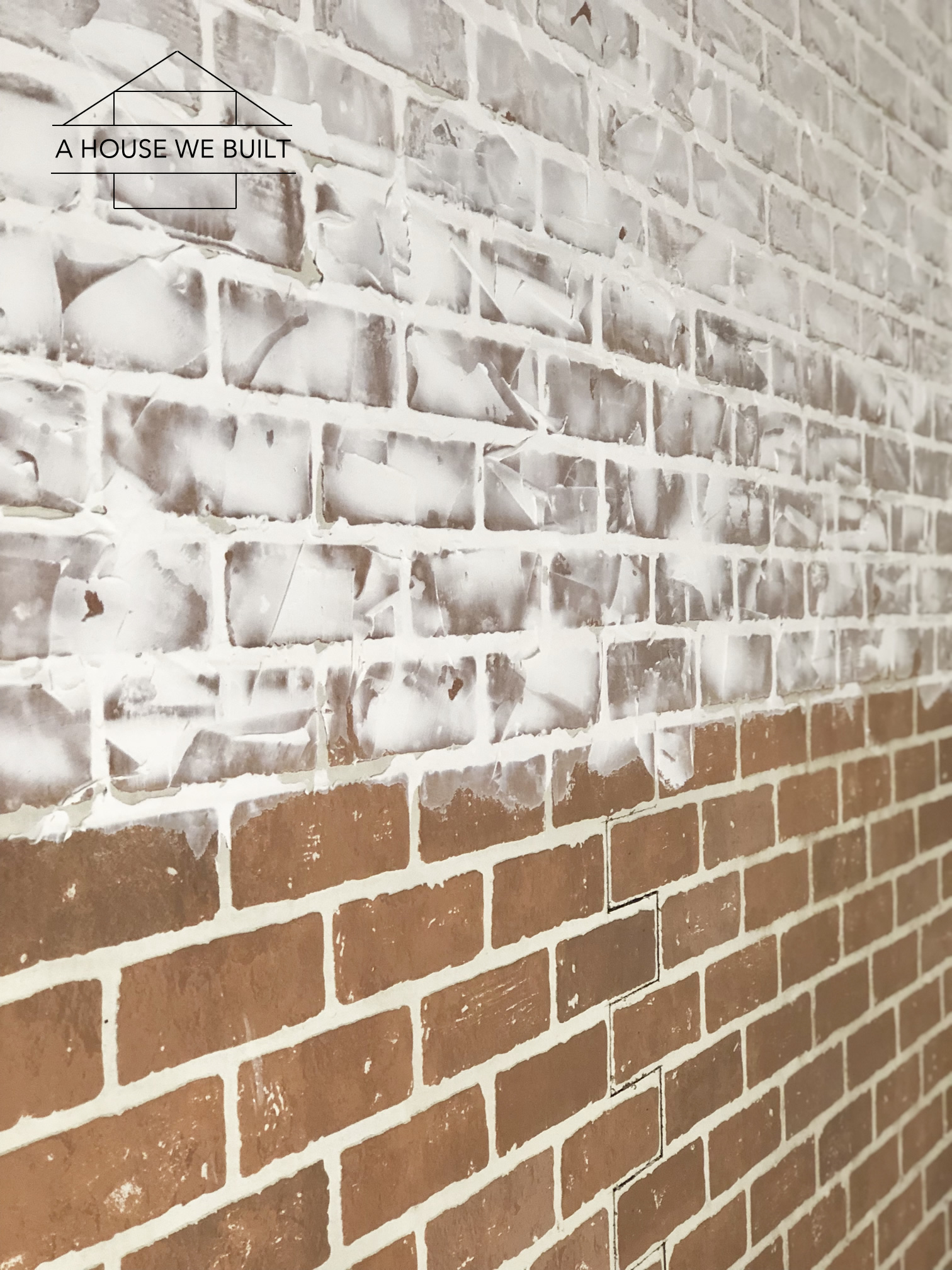
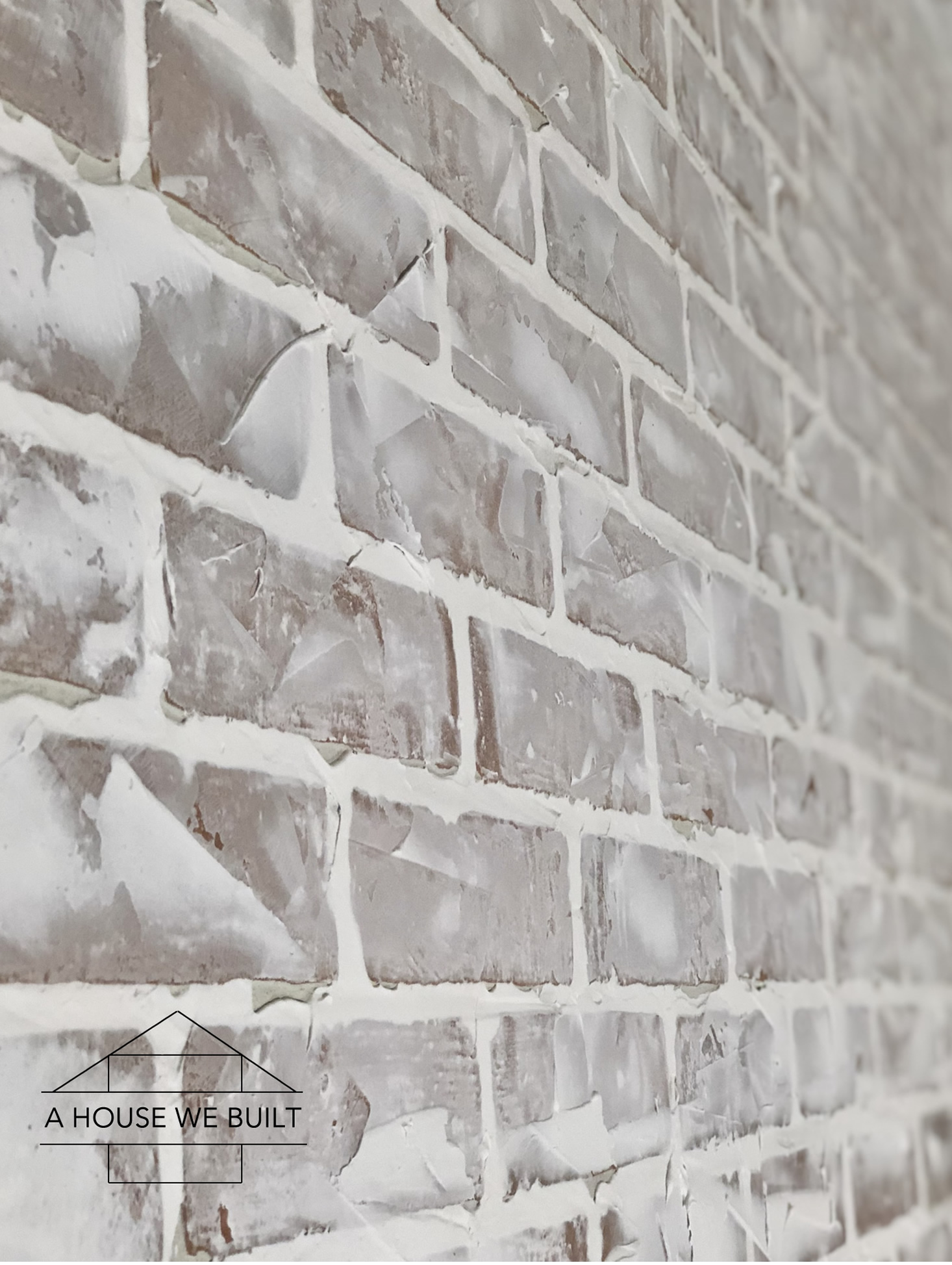
Note: as the compound dries a little (which it will as you work, even if you use the 24 hour drying one I recommend), you’ll notice that the color will become a little lighter. This means that your work might look inconsistent when you step back to look at it all together, but it’s actually not. So make sure you take this into account when you’re comparing the areas you’re currently working on to the areas you previously worked on for consistency: it will look a little whiter as it dries. But when I say “dry” I mean that in a light sense. It took me 2.5 hours to “schmear” this whole wall and at the end, I was still able to go back and fix up the area I started with so don’t worry about it fully hardening until you leave it overnight.
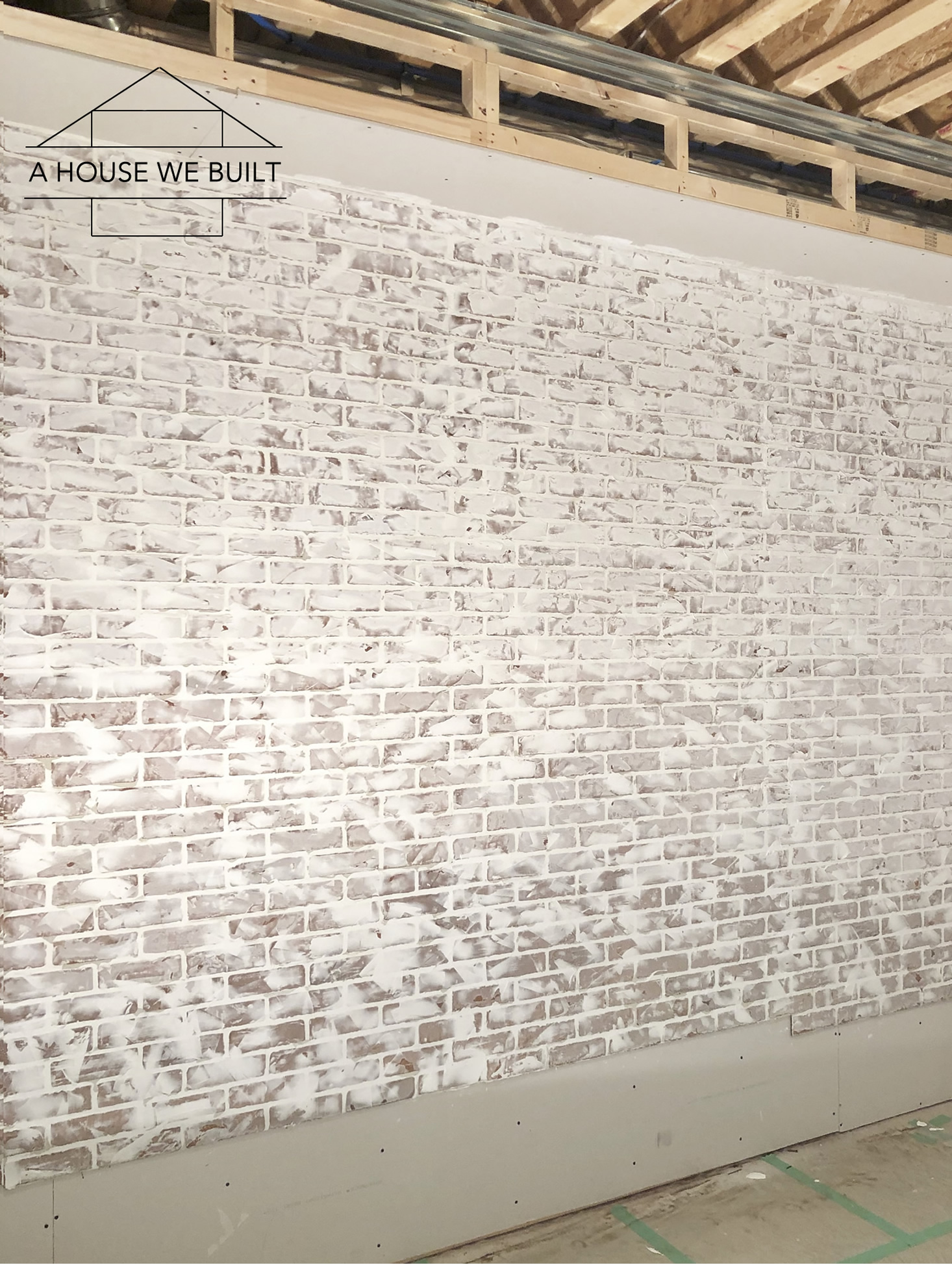
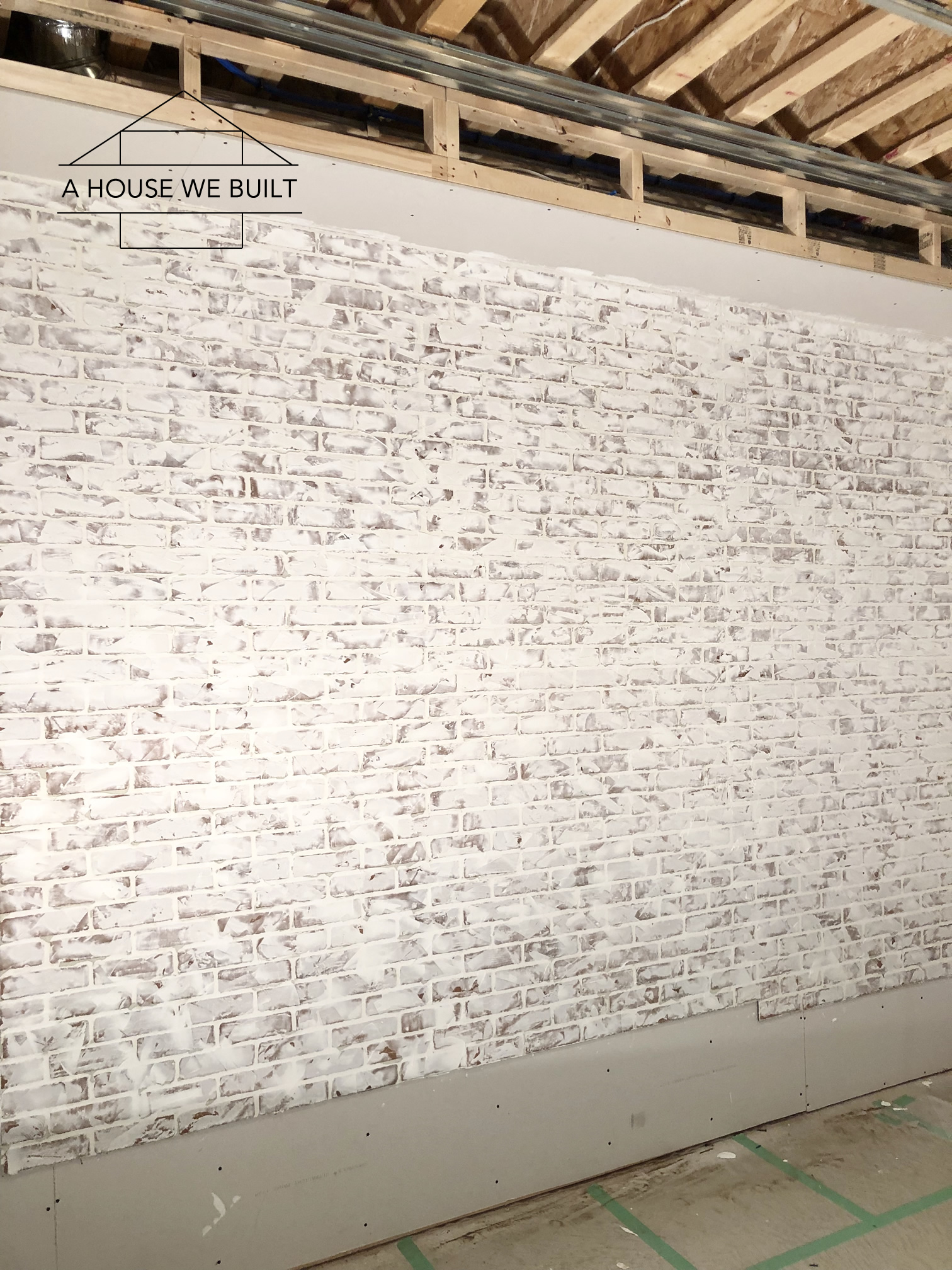
These pictures above show you what I mean. Left Pic was taken right as I finished and you can see how the coloring looks inconsistent since the different areas of the wall were at different drying stages. Right Pic was taken the next morning and you can see the color fully evened out as the whole wall dried.
OPTIONAL FINAL STEPS.
So, what you’ve seen here is as far as I’ve gotten in this project and I think it’s where I’m going to pause until we get the rest of the basement to the finishing stage since I’m not entirely sure how I want the final wall to look and the less I do right now, the more options I’ll have down the line.
One option is to just leave it like this. My faux brick wall will have lower cabinetry below it so since it’s not a wall anyone will be leaning on, it doesn’t really “require” a top coat.
Option 2 is to “set” the wall with some kind of top coat but make sure it’s one that won’t yellow over time.
Option 3 is to “set” the wall with a mixture of 25% paint to 75% water if you want an even more white-washed look than you already have. I am considering doing this with 25% of our final wall color so that this brick wall will be the exact same white color as what the surrounding walls will be.
Option 4 is to go all the way and fully paint it whatever color your want (in my case it would be white). White brick is a gorgeous look! You could keep the schmear messy or sand it down first.
If you want a smoother wall, you can take a sanding sponge and knock off any high spots (I don’t want a smooth wall so I won’t be doing this, but it’s a possibility, even if you change your mind after it dries).
If you feel you’ve used too much compound and you want more of the original brick color to show through, you can also use a sanding sponge to remove a little of the compound (I might end up doing a little of this, haven’t decided yet). And actually since this compound is water soluble, while you’re applying it, you can also use a damp sponge to remove some of the compound if needed.
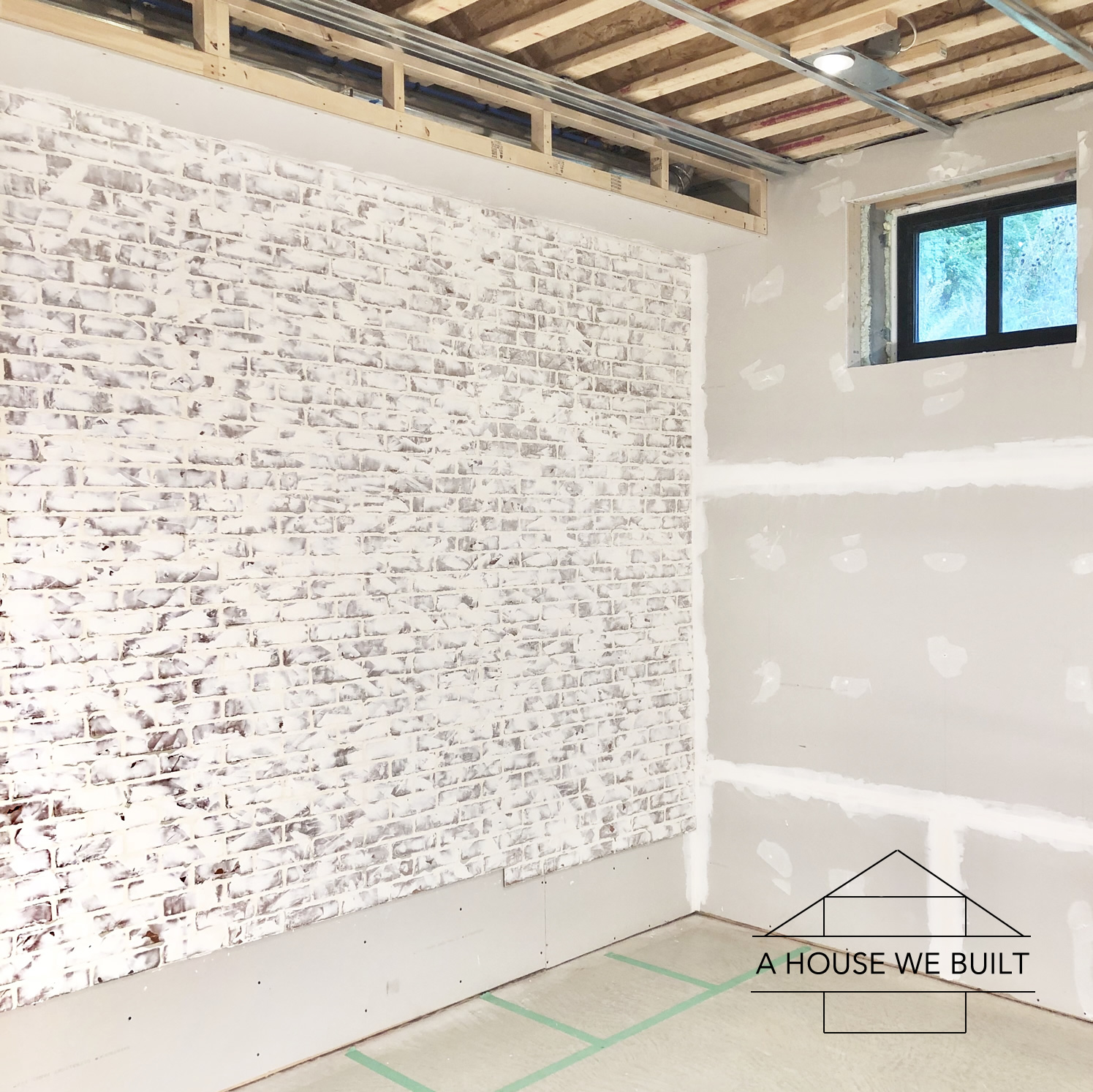
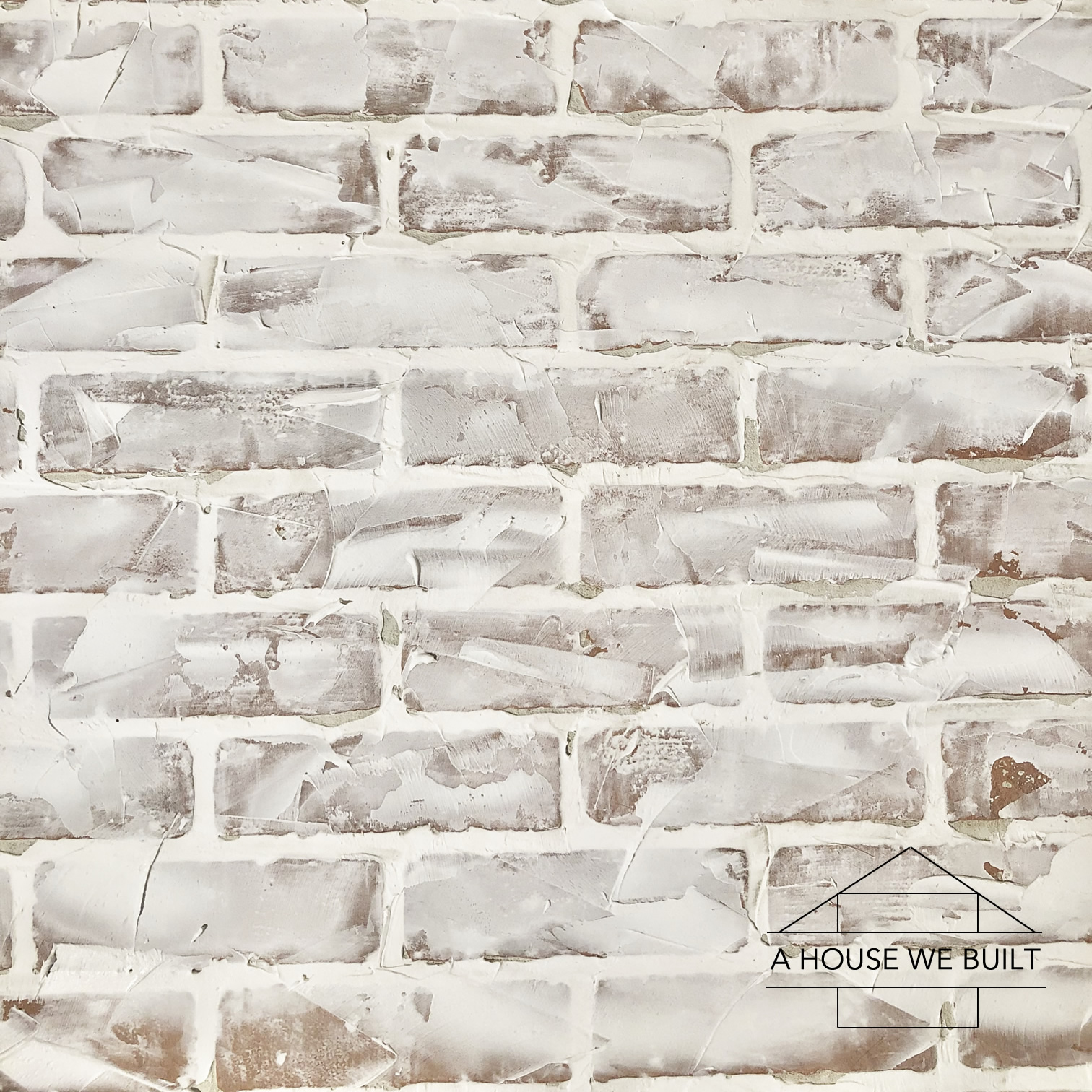
So there you have it! This is how we made our faux brick wall! I hope this tutorial was helpful 🙂
Below is a final picture of how this wall turned out. See more of this room on our Game Room page!
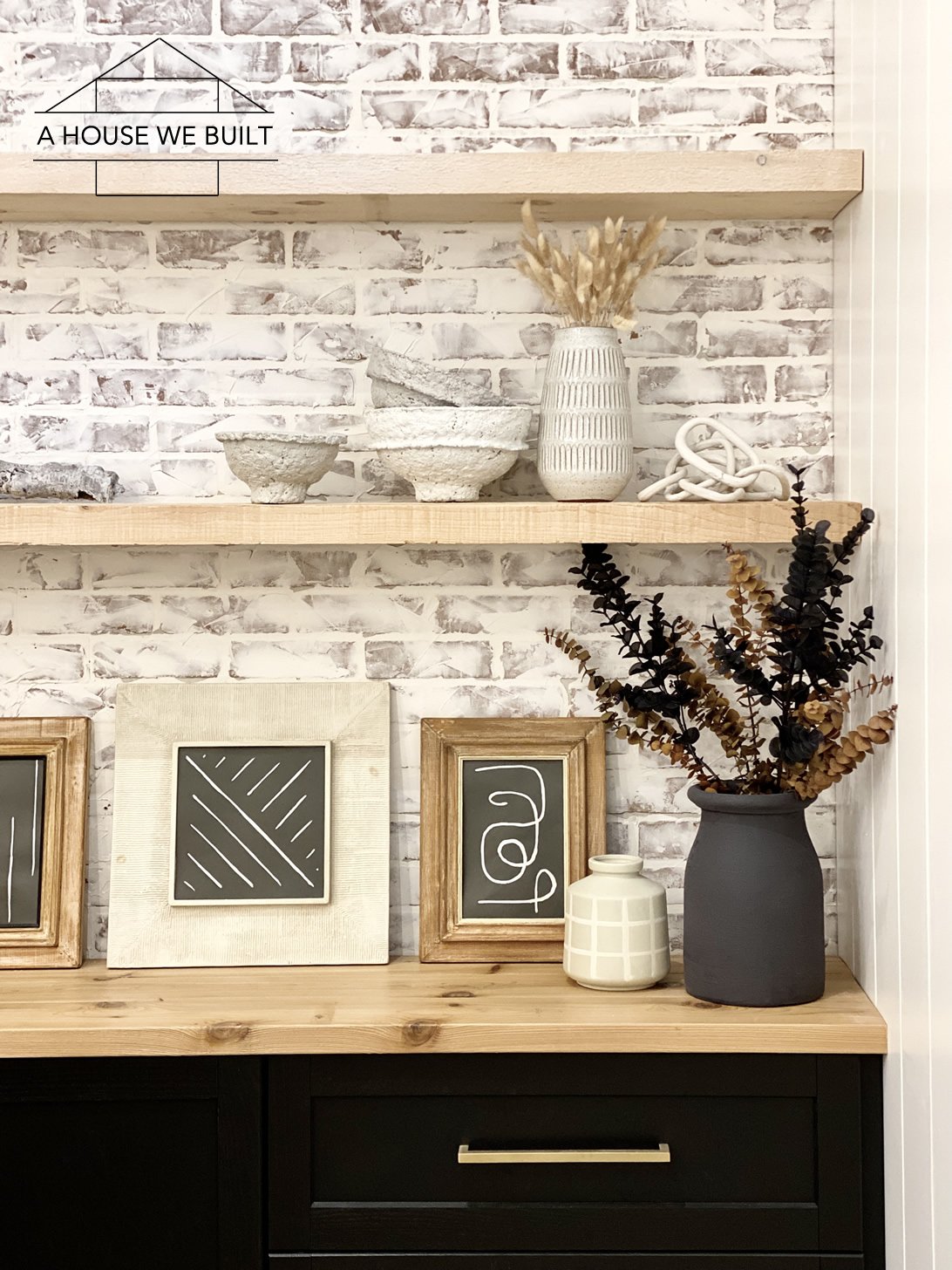
If you have any questions, leave a comment and I’ll get back to you.
For more of our tutorials, click here.
To explore the other rooms in our house, click here.
For our daily progress, follow us on Instagram @ahousewebuilt.
Sarah says
Looks great!! How did you finish off the wall on the top and bottom?
admin says
At the top, I just did a full board then was just very careful with how I did the schmear there so that I didn’t go onto the ceiling but I got into the crack between the top of the brick and the ceiling. Basically just treat it like any other part of the wall but dont goop the ceiling.
Denise says
Thanks for posting this technique on your page. We have 16 foot wall that we wanted to do with these 4×8 sheets of faux brick panels. I was indecisive about how to make it look as real as could be. But you had some great tips on how to do it. Love all your DIY projects
admin says
You’re welcome! It works really well if you take the time to cut and blend the seams. Best of luck with your wall 🙂
Stephanie says
My faux brick wall panels are in my cafe. I want to be able to wipe it if someone gets it dirty and also don’t want people to rub it off. WhAt can i use to seal it? I thought about paint but wanting some of the brick to show thru so really didn’t want to use white.
admin says
I’m not an expert on this but I suppose some kind of clear/matte floor sealer would work? Maybe test it first to be sure a) it actually works and b) it bonds to the compound since I don’t really know if it would.
Jenelle says
I have read to use a polycrylic and NOT. A polyurethane product as it will hello.
admin says
Yeah, certain types will yellow. I did not do any top coat.
Claire says
This is the most amazing blog post I’ve ever read. We exposed so much brick in our Pittsburgh southside city row house. But the sound that travels between our wall and the neighbors (who also exposed The brick wall), is so loud. We worked so hard exposing the brick and for 5 years I’ve been trying to find a solution. I keep thinking a clear soundproofing epoxy is on its way to market, but nothing yet. This is a great option for us to not do anything permanent to the walls we exposed, and add brick look a like on top. I think we’ll frame out the brick walls with metal studs. And either add insulation or soundproof drywall and then adhere bricks to drywall. I may even go one step further and use the green glue soundproof adhesive on the back of the panels (or drywall should we do that) lots of thoughts bouncing around in my head. And while I love our RED pre-1900 brick, I really want to see how white brick will look in the house. And I just don’t have the heart to paint our real bricks yet. And while I’ve researched sound proof paint, I’m not sure it would help enough. This is such a wonderful solution to my half decade problem. Thanks for all the research. This mama is confident now. ♥️♥️♥️
admin says
Ha! I’m so glad this was helpful! Just my own two cents – I think you’re on the right track with the green glue. I’ve heard good things about that option. Another thing to consider is double drywall with green glue in between – especially when coupled with acoustic insulation in the walls – can be quite a good sound barrier from what I’ve heard.
Best of luck with your project!! 🙂
Sasha says
Would this work for a backsplash? I love the brick for my kitchen wall in our new build but it’s so pricey and I’m afraid with real brick it would get dusty and be harder to clean.
admin says
If you really wanted to, in theory it could as long as it was very very very very well sealed (like multiple layers of top coats – which might be tricky to find one that didn’t yellow over time) to make it cleanable. Overall though it’s not a product I’d recommend for a backsplash – better to go with brick-like tile honestly.
Kim says
I really admire your entire home (and the cat rescue). What would you have done if you had a window on the wall you wanted to do this?
admin says
Thank you 🙂 Probably the same thing, but with trim around the window. If you’re not doing window trim, then in our shiplap tutorial I show how we terminate shiplap to an outside corner without wrapping it and I’d use the same concept with the brick but probably with a thicker piece of trim inside the window box to give the illusion of a thicker brick (since this is just a panel).
Cheyenne says
I like the red brick color, do you think it would look good to leave panels as they are? I love following your home!
admin says
Only if you didn’t need to join them – otherwise the seam would be quite visible. Though I supposed you could do some sort of trim detail over the seam.
Amy Wolsey says
What did you end up doing as the final step ? A full coat of paint or the 25/75 mix. I’m debating what to do on ours. If I did the 25/75 mix of paint to water would it still leave some of the brick color or would you boot some off? I love your home! Thanks you
Amy Wolsey says
Blot**
admin says
I actually never did a final coat in the end! It’s currently exactly how I left it at the end of this tutorial. As far as the paint/water thing goes, I feel like that’s a personal choice depending on what you want it to look like – there’s no right or wrong answer. You can always try blotting it and if you don’t like that just re-roller over it, but it’s really up to you. 🙂
Kerti says
Did your panels come with the light colored grout already or did u hv to paint it? Our Home Depot sells the panels w a dark grout and I really don’t want to hv to paint the grout first and then schmear it.
admin says
The pictures in Step 1 are as the panel came and the source link I provided has the same panels available. If your store doesn’t have them, you can order them online and have them shipped to your local store.
Paige Bogle says
I know you had this listed above, but does the compound dry a white color and not a cream color? I bought the kind suggested above and it looks like a cream color when applied to the brick panel. I just want to double check and make sure that is dries white.
admin says
It dries exactly the color shown in my pics. I have not painted it since so all pics of this room (and the brick in our theater room) are the raw compound color. It’s a warmer white than, say, primer paint.
Stephanie says
I’m having the same problem with it drying more cream/yellow than white. I really don’t want to paint/whitewash it because I don’t want to color more brick, but the grout lines not drying white is really bothering me. I’ve tried 3 different brands.
admin says
I linked the exact joint compound I used in my post if you want to try that one (as mentioned though I mix mine with water). It dried a warm white. I ended up liking the white so much that I never painted over it and all my pictures of this room are just the joint compound alone (and no filters on the pics)
Hunter says
Hi,
Do you happen to still have the link to the brick panels you used? Unfortunately the hyperlink to Home Depot isn’t working for me.
admin says
Link is fixed. I think they must have changed the SKU or something but I found the product again and it appears to be identical (same look, brand, name, specs) and updated the link.
Vicki Frye says
I just did this and I am struggling as the red from the brick is bleeding thru once the compound dries
admin says
If you’re using the same brick product as me, the red color is fixed to the panel and cannot “bleed”. If you’re simply referring to the fact that you feel you’re still seeing too much of the red show through though, that most likely means that you didn’t use enough compound and simply need to layer on more until you achieve the look you’re going for. Alternatively, you can paint over it with a mixture of paint & water to whitewash it, or even full paint depending on the degree of white you’re looking for.
ksm says
This is exactly what I want to do in a bedroom! Quick question…my wall is exactly 12 ft wide. Wouldn’t that mean I would be short once I interlock the panels or am I overthinking it? This is why I haven’t started yet. 😂
admin says
Probably. Well, an option would be to add a border of trim around the whole wall – could be smooth material or even raw wood – that could essentially eat up the extra space evenly on all sides while making it look intentional.
BC says
I am getting ready to do this tomorrow in my garage. Been back and forth with weather to cut out the individual bricks because I couldn’t find many posts that did it but it’s what made sense to me. I am not looking to add the white to the wall but just add grout in the seam.
What are your thoughts on that?
I also have bare studs and no drywall so I was just going to nail it and not use the adhesive.
I noticed your ceilings are a higher than 8ft as well so they are not flush to the ground or baseboard for support. They are pretty heavy panels so I’m hoping they stay up
Thanks for the tips
admin says
The manufacturer specs say to use both adhesive + nails. You could still do both in your situation by applying the adhesive directly to the studs prior to putting the panels up. Alternatively, you could throw in a few black screws here and there into the studs to really secure it. But I would not recommend only nailing the panels.
And I suppose you could just grout the seam but the grout color on the panels is not a perfect white so it may be harder to match perfectly. If it doesn’t work, you could always just apply a light schmear over the wall to draw attention away from the seams.
However, since you’re not doing drywall, if the seam between boards doesn’t land directly over a stud, I’d worry about not having support directly behind the interlocking flaps which would make grouting them and/or hiding the seam harder (and possibly more prone to cracking long term). Just something to consider.
lauren hodlin says
This is exactly what I want to do to our ventless fire place. Im concerned about the yellowing though. So I wanted to use this paneling on the outside of the fire place, but obviously its going to get warm from the fire.
Do you still think this is a good option to achieve this look?
admin says
You’d have to check with the manufacturer but I do not believe this material is intended to be used around a real fireplace – it does not have the same function as real brick.
Jewels says
I’ve read some others had issues with their compound turning a little pink/orange from scraping it on the bricks. Did this happen to you?
admin says
No, but if they used a different brick product than I did that could be why. In the end, I never even painted mine because it retained a nice warm white color I liked.
Sandy says
Do you think it would be a good idea to use this technique as my kitchen backsplash? And also on the wall over my stove?
Thank you
admin says
Not unless you find a way to seal it very well.
I would not recommend anything other than tile for a kitchen.
Mallory says
do u think if I was mounting the Tv I should cut the faux brick where the mount would be ? Or do you think it would be fine on the brick if we hit the studs
admin says
My feeling is that if you attached it to the studs, you would not have to cut the brick. Just don’t hang it off the bricks alone.